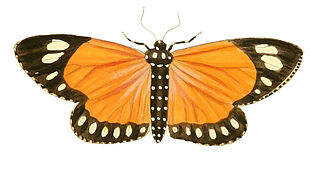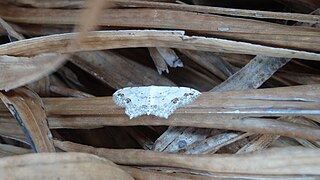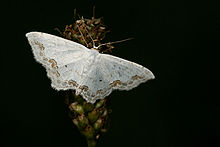
The geometer moths are moths belonging to the family Geometridae of the insect order Lepidoptera, the moths and butterflies. Their scientific name derives from the Ancient Greek geo γεω, and metron μέτρον "measure" in reference to the way their larvae, or inchworms, appear to measure the earth as they move along in a looping fashion. A very large family, it has around 23,000 species of moths described, and over 1400 species from six subfamilies indigenous to North America alone. A well-known member is the peppered moth, Biston betularia, which has been subject of numerous studies in population genetics. Several other geometer moths are notorious pests.

Petrophora chlorosata, the brown silver-line, is a moth of the family Geometridae found in Asia and Europe. The larva feed on bracken. It was first described by the Italian physician and naturalist, Giovanni Antonio Scopoli in his 1763 Entomologia Carniolica.

Scopula decorata, the middle lace border, is a moth of the family Geometridae. It is found throughout Europe.

Scopula immutata, the lesser cream wave, is a moth of the family Geometridae. It was described by Carl Linnaeus in his 1758 10th edition of Systema Naturae. It is found throughout Europe.

Minoa murinata, the drab looper, is a moth of the family Geometridae. The species was first described by Giovanni Antonio Scopoli in his 1763 Entomologia Carniolica. It can be found in southern and central Europe, Great Britain, Anatolia, the Caucasus and the mountains of central Asia and Mongolia.

Scopula is a genus of moths in the family Geometridae described by Franz von Paula Schrank in 1802.

Scopula ternata, the smoky wave, is a moth of the family Geometridae. It was described by Franz von Paula Schrank in 1802. It is mainly found in northern and parts of central Europe and in isolated populations in southern and south-eastern Europe. Its western range is eastern France, eastern Belgium and Scotland, with an isolated population in the Pyrenees. In the north its range extends to the polar regions and in the south it is found up to the Alps. Its eastern range extends through central and northern Russia up to the Ural, through Siberia up to the Yenisei River.

Scopulini is a tribe of the geometer moth family (Geometridae), with about 900 species in seven genera. The tribe was described by Philogène Auguste Joseph Duponchel in 1845.

Scopula limboundata, the large lace-border, is a moth of the family Geometridae. It was described by Adrian Hardy Haworth in 1809. It is found in North America east of the Rocky Mountains. There is a single and unconfirmed record from Great Britain.

Scopula virgulata, the streaked wave, is a moth of the family Geometridae. The species was first described by Denis & Ignaz Schiffermüller in 1775. It is found from most of Europe to central Asia and northern Mongolia.

Scopula emutaria, the rosy wave, is a species of moth in the family Geometridae. It is found in western and south-western Europe and Romania. Also in North Africa.
Scopula asellaria is a moth of the family Geometridae. It was described by Gottlieb August Wilhelm Herrich-Schäffer in 1847. It is found in southern Europe and North Africa.
Scopula indicataria is a moth of the family Geometridae. It is found in China, Korea, Japan and Russia.

Scopula beckeraria is a moth of the family Geometridae. It was described by Julius Lederer in 1853. It is found in Italy, Croatia, North Macedonia, Greece, Bulgaria, Romania, Ukraine, Russia, Turkey, Armenia, Israel, Lebanon, Iran, Turkmenistan and Kazakhstan.
Scopula confinaria is a moth of the family Geometridae. It is found in southern Europe, southern Russia and Turkey.
Scopula coniaria is a moth of the family Geometridae. It was described by Prout in 1913. It is found in Japan and Russia.

Scopula corrivalaria is a moth of the family Geometridae. It is found from Japan, Korea, China and the Russian Far East through Siberia and Russia to western Europe. In Europe, it ranges from northern Central Europe to the Mediterranean. The habitat consists of marshes and wet meadows.

Scopula helcita is a moth of the family Geometridae first described by Carl Linnaeus in his 1763 Centuria Insectorum. It is found in Cameroon, the Republic of the Congo, the Democratic Republic of the Congo, Equatorial Guinea, Ghana, Nigeria, Sierra Leone, South Africa and Uganda.

Scopula submutata, the Mediterranean lace border, is a moth of the family Geometridae. It is found in southern Europe, North Africa and the Near East. The habitat consists of open, dry grassland and rocky slopes.

Scopula pulchellata is a moth of the family Geometridae. It is found in the Indo-Australian tropics, from India, Sri Lanka to Taiwan and the Solomon Islands, as well as in Africa.














